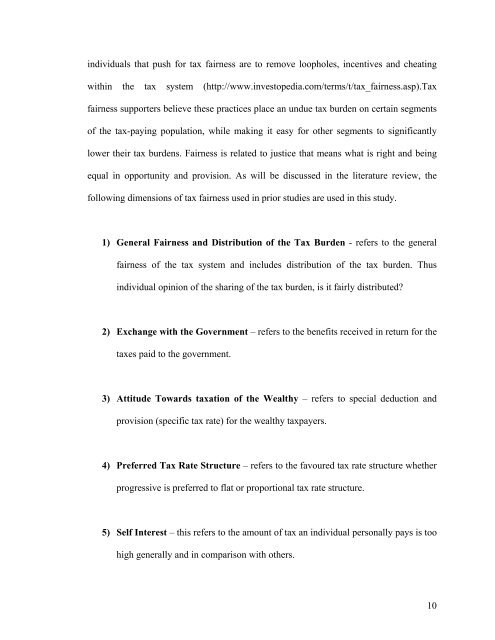1 CHAPTER 1: INTRODUCTION 1.0 Chapter ... - DSpace@UM
1 CHAPTER 1: INTRODUCTION 1.0 Chapter ... - DSpace@UM
1 CHAPTER 1: INTRODUCTION 1.0 Chapter ... - DSpace@UM
You also want an ePaper? Increase the reach of your titles
YUMPU automatically turns print PDFs into web optimized ePapers that Google loves.
individuals that push for tax fairness are to remove loopholes, incentives and cheatingwithin the tax system (http://www.investopedia.com/terms/t/tax_fairness.asp).Taxfairness supporters believe these practices place an undue tax burden on certain segmentsof the tax-paying population, while making it easy for other segments to significantlylower their tax burdens. Fairness is related to justice that means what is right and beingequal in opportunity and provision. As will be discussed in the literature review, thefollowing dimensions of tax fairness used in prior studies are used in this study.1) General Fairness and Distribution of the Tax Burden - refers to the generalfairness of the tax system and includes distribution of the tax burden. Thusindividual opinion of the sharing of the tax burden, is it fairly distributed?2) Exchange with the Government – refers to the benefits received in return for thetaxes paid to the government.3) Attitude Towards taxation of the Wealthy – refers to special deduction andprovision (specific tax rate) for the wealthy taxpayers.4) Preferred Tax Rate Structure – refers to the favoured tax rate structure whetherprogressive is preferred to flat or proportional tax rate structure.5) Self Interest – this refers to the amount of tax an individual personally pays is toohigh generally and in comparison with others.10
















